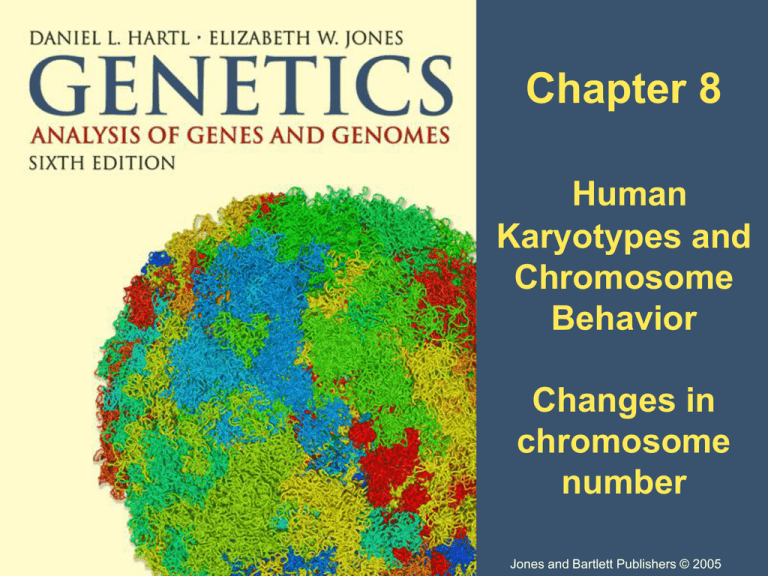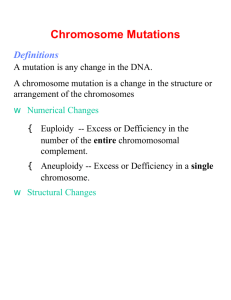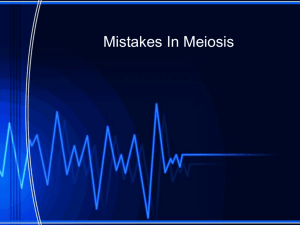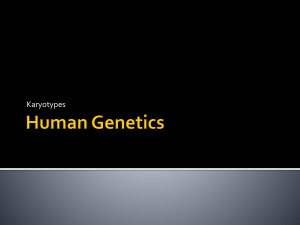third of three for Chapter 8
advertisement

Chapter 8 Human Karyotypes and Chromosome Behavior Changes in chromosome number Jones and Bartlett Publishers © 2005 Topics for today’s lecture • Changes in chromosome number - sets of chromosomes - gain or loss of individual chromosomes - examples of aneuploidy in humans Two kinds of polyploidy Multiplication of the entire chromosome complement is called polyploidy. When all the genomes are the same, it is called autopolyploidy. When two (or more) different genomes are duplicated, it is called allopolyploidy. Formation of a tetraploid organism Creation of a totally homozygous diploid cell by doubling of chromosome number in a monoploid cell by colchicine Monoploid cells can only be grown in plants. In humans, the only viable monoploid cells are the egg and the sperm. Monoploidy in somatic cells is lethal. Terms for sets of chromosomes • Monoploid = basic, standard number of chromosomes that contain one copy of each gene found in the species. • The letter X is used to designate the monoploid set. X = Humans-23, Drosophila-4, chicken-39, cattle-30, pigeon-40, tobacco-12, Arabidopsis-5, wheat-7 pea-7, oak-12. Dysploid = a change in monoploid number. Terms for sets of chromosomes • Euploid = one or more complete sets of chromosomes. • Polyploid = three or more complete sets: haploid (N) set diploid = 2X N=X triploid = 3X tetraploid = 4X N = 2X pentaploid = 5X hexaploid = 6X N = 3X duodecaploid = 12X N = 6X Common mechanisms by which polyploids are naturally produced Colchicine can be used to block segregation of chromosomes at anaphase results in production of polyploids. Where does chromosome doubling occur? Chromosome doubling during meiosis Diploid gametes Types of polyploids • Autopolyploids = individuals with extra copies of the monoploid set of chromosomes. • Allopolyploids = result from combinations of monoploid sets from several species. Sedum suaveolens, 2n=640, x=8 Flow cytometry • Ploidy determinations can be made using chromosome-specific fluorescent dyes and a cell sorter. • Results need to be confirmed by classical cytogenetics. • Efficient for screening for haploids, dihaploids, etc. • Amphiploid – doubled wide hybrid. diploid prg Med. tf (6x) KY31 tf (6x) Med tf + diploid contam. Tall fescue, 2n=6x=42 (above left) Wide hybrid, 2n=8x=56 (below left) Meadow fescue, 2n=2x=14 (above right) Wide hybrid, 2n=12x=84 (below right) Genomic in situ hybridization Where does chromosome doubling occur? Chromosome doubling in meristematic tissue autotetraploid clone. Production of new species of Brassica These are naturally occuring species of Brassica produced by all possible combinations of hybridizations and polyploidization Gamete production by polyploids Problems with being triploid failure of chromosomes to segregate properly. This is why triploid watermelons are seedless. Origins of a fertile tetraploid by hybridization between 2 diploid species = Allotetraploid Bread wheat An allopolyploid with two sequential polyploidization events Production of New World cotton by hybridization of two species Tetraploids can make 6 kinds of gametes Tetrasomic inheritance results in many more gamete and zygote combinations. Aneuploidy • Aneuploidy is a gain or loss of individual chromosomes. • Normal diploids are disomic. • Trisomic = diploid with one extra chromosome (2X+1). • Monosomic = loss of a single chromosome (2X-1). Aneuploidy • Tetrasomic = two extra copies of one chromosome (2X + 2). • Nullisomic = individuals that have lost both copies of a particular chromosome (2X-2) • Double monosomics = ? • Double trisomics = ? Datura stramonium Capsule phenotypes for normal + 12 aneuploids (in this case, a trisomic series). Human aneuploidy • Humans, and animals in general, can’t tolerate much chromosome aberration. • In humans, aneuploids for X, Y, 13, 18 and 21 can survive to birth. • Trisomy 13 = Patau syndrome • Trisomy 18 = Edwards syndrome • Trisomy 21 = Down syndrome Trisomy 21 Down Syndrome Sex chromosome aneuploidy in humans Syndrome Name Turner Normal females Triplo-X Nullo-X Normal males Male Klinefelter Sex Chromosomes Frequency XO 1/2500 f XX XXX, XXXX, XXXX 1/700 b Y lethal XY XYY 1/1000 m XXY, XXXY, XXXXY 1/500 m Kleinfelter’s Syndrome Karyotype XXY Conserved linkages (synteny groups) in cereal grasses








